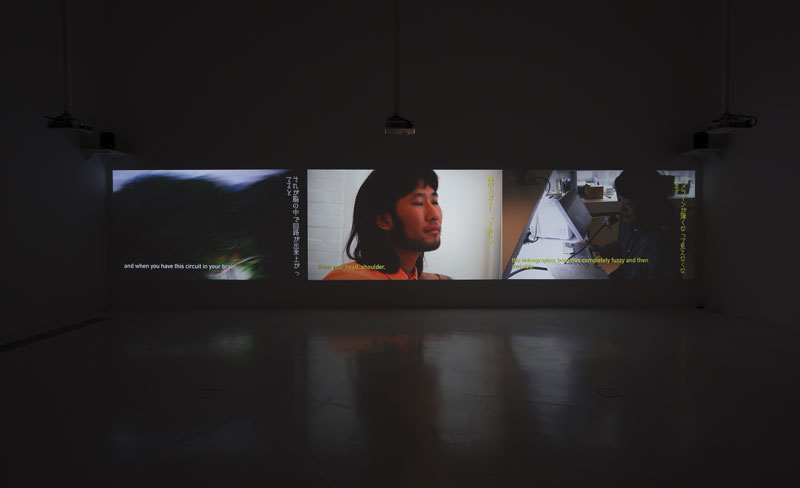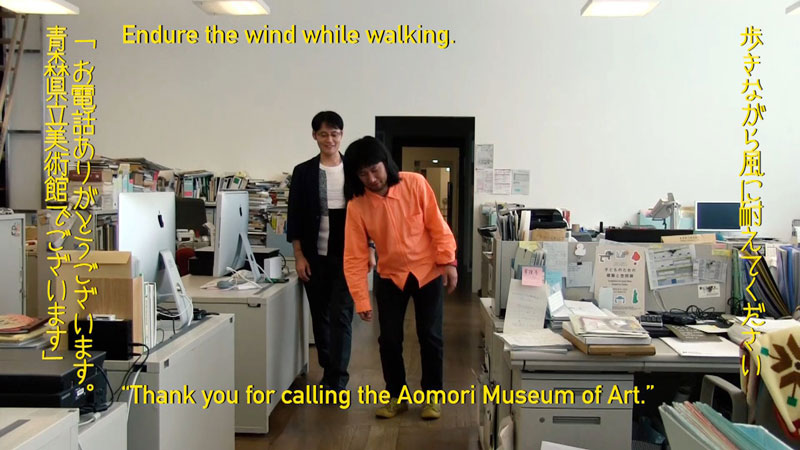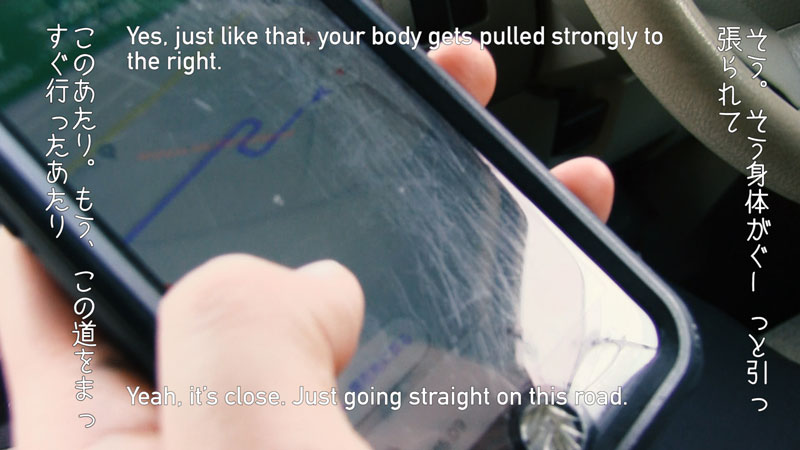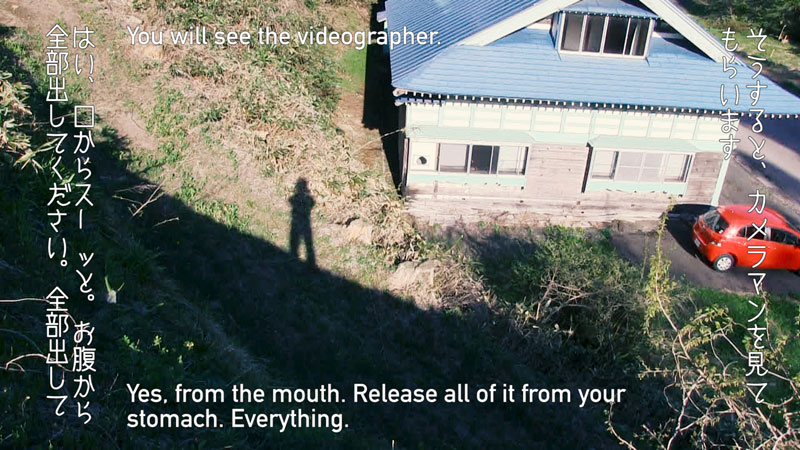Hypnotising Land Ownership, 2019

「青森EARTH2019:いのち耕す場所 -農業がひらくアートの未来」、青森県立美術館、青森、2019での展示風景
写真:大西正一
Installation view "AOMORI EARTH2019: AGROTOPIA –WHEN LIFE BECOMES ART THROUGH LOCAL AGRICULTURE", Aomori Museum of Art, Aomori, 2019
Photo by Masakazu Onishi



ビデオスティル、2019
撮影:丹羽良徳, 奥脇嵩大
Video still, 2019
Video by Yoshinori Niwa and Takahiro Okuwaki
土地所有権に催眠をかける
2019年, 3チャンネルのHD映像(28分55秒)
人類史において「農耕」の発明は食料を計画的に生産し貯蓄する術をもたらし、それまで家族単位であった人類の社会形態を拡大させ現代のように多くの人々が定住生活を営むことを可能とし、文明・政治・経済を生み出す国家の礎ともなった。人類はその社会生活を整備するため「所有権」を発明し、さまざまな動産、不動産、サービスなどに適応させたが、同時にさまざまな紛争も引き起こした。この作品は、我々が現在暮らす集団的な社会生活の基礎を作った農耕とその土地所有、そして土地所有の変遷に光をあてる。
この作品は、相続問題や大規模な農業会社の進出などにより耕作されないままの農地いわゆる「耕作放棄地」のヒアリングから始めた。この用語は農林水産省による統計調査(農林業センサス)で定義され、「所有されている農地のうち、過去1年以上作付けされておらず、この数年の間に再び作付けする考えのないもの」を指す。しかしながら、この問題は「誰にとって」のなのであろうか?農地を放ったらかし食料自給率を下げているというのであれば、社会全体の問題かもしれないし、害虫が発生し近隣への悪影響を及ぶすのであれば、所有者だけの問題に留まらない。他者との絶対区別を約束するはずの「所有」という概念を土地に適応した場合の不可能性が見えてくる、むしろ土地がそもそも抱える社会の共有財であるという側面が浮かび上がる。
作品撮影の序盤では、催眠術師に協力を依頼し耕作放棄地を管理する者、所有するもの、そして部外者である丹羽良徳、それぞれの意識を交換しその農地の歴史や放棄地を巡る座談会を企てた。それにより、土地所有の問題を全く別の角度から切り込みを入れようと企んだが、ほとんどの行政機関から断れた。そのなか、青森県三沢市からは催眠をかけた上での撮影協力を得ることができた。催眠クリエーター田村さんに依頼し、耕作放棄地となった土地を管轄する行政関係者、農業委員会との座談会では、農地管理に関わる方々が『土地所有者』、丹羽良徳が『行政関係者』となるような催眠術を試みたが、残念ながら催眠をかける事が叶わず失敗に終わる。
その後、美術館に催眠技術家の岩井隆介さんを招き、丹羽良徳に展示準備をする美術館内で田んぼに見える催眠をかけ、事務所や展示室などを徘徊した。丹羽良徳は、2019年現在青森県が管理する美術館内部からかつて「その場所」に存在したはずの田んぼの幻覚を見ることによって、観客には決して見ることのできない方法で、その土地所有の変遷について自らの身体を持って体験し考えを巡らせようとした。
現在この映像作品を展示している青森県立美術館が立地する三内丸山遺跡周辺は縄文集落→林→田んぼ→住宅地→遺跡のように時代とともに変化したと言われる。この場所に遺跡が存在することは、江戸時代から知られていたと言われ、1992年の調査によって大規模な集落が存在していたことが判明し、これにより青森県はすでに着工していた野球場建設を中止し、遺跡保存を決めた。それにより、結果的にあなたは今この場所でこの映像を見ることができるわけだが、我々が今現在足をつけているこの地面が何者かによってどのように分割所有され、そして時には都合よく保存されてきたのかを見ることができているのであろうか?
Hypnotising Land Ownership
2019, Three-channel HD video (28 min 55 sec)
The invention of “farming” in human history brought us a way of producing and saving food systematically and expanded the social structure of human beings, which only existed in the units of family until then, to make it possible to live a settled life like the present day. It also became the basis of the state that creates culture, politics and the economy. Human beings invented “property rights” in order to organise that social life and applied it to various movable property, real estate and services, however, it caused many conflicts at the same time. This artwork sheds light on farming that is the basis of the collective social life today, land ownership that came from farming, and the transition of land ownership.
In this work, Yoshinori Niwa started with an interview about the so-called “abandoned farmland”, a farmland left not being cultivated because of inheritance issues and the rise of large-scale farming companies. This term is defined in the statistical survey (Agriculture and Forestry Census) by Japan’s Ministry of Agriculture, Forestry and Fisheries as “a farmland owned by someone that has not been cropped for over a year and has no plans of cropping again in the next few years”. Whose problem is this? If it lowers the food self-sufficiency rate by abandoning the farmland, it might be an issue of the whole society. Or, if it causes pest problems and affect others, it would be more than just the owner’s issue. The idea of property rights is supposed to promise absolute distinction from others, but we can see the impossibility of applying this idea to land. Rather, another side of the concept of land, being a common property in the first place, arises from this.
At the beginning of filming this work, Niwa planned to ask a hypnotist to exchange consciousness between the people who manage abandoned farmlands, owners and outsider Niwa, and to have a discussion meeting over the history of the local agricultural lands and abandoned farmlands. By doing so, Niwa wanted to open a new approach to think about the issue of land ownership. While most local governments rejected the offer, the Misawa City government agreed to film their meeting under hypnosis. Niwa asked hypnosis creator Mr. Tamura to provide hypnosis for the discussion meeting with the local government officials, who manage abandoned farmlands, and agriculture committee. The hypnotist tried to exchange their consciousness, that of government official to landowner and that of Niwa to government official, but unfortunately, the attempt of hypnosis ended in failure.
Then Niwa invited another hypnosis technician Ryusuke Iwai to the museum to put him under hypnosis, making him see hallucinations of rice fields inside the museum where the exhibition preparation was going on, and they loitered in the office and exhibition spaces. Niwa thinks over the history of land ownership of the space and its transition by experiencing it through his body—by seeing hallucinations of rice fields that were once there, where the museum is currently located under the management of the Aomori government—in a way that the audience would never be able to see.
It is said that the area of the Sannai-Maruyama site, where now the Aomori Museum of Art is located and showing this video work, has transformed from Jomon villages to forests, rice fields and residential areas, and ended up as ruins with the times. It is also said that people knew there were ruins around this area since the Edo period. The fact that a large-scale village existed there was revealed due to an investigation in 1992, and the Aomori government decided to cancel the baseball field construction that was already in progress and to preserve the ruins. Thereby, as a result of this, you are able to watch the video right here and right now, but are you seeing how this land where we are now standing has been divided and owned by someone, and moreover been conveniently preserved at times?
Review 美術手帖(JP) Review 青森県立美術館(JP)